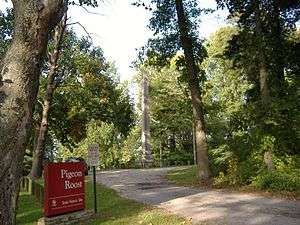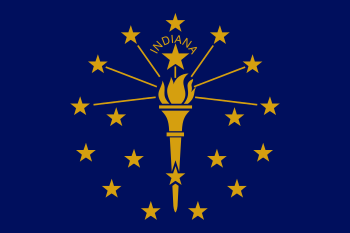Pigeon Roost State Historic Site
Pigeon Roost State Historic Site is located between Scottsburg and Henryville, Indiana, near Underwood, Indiana. A one-lane road off U.S. Route 31 takes the visitor to the site of a village where Indians or Native Americans massacred 24 settlers shortly after the War of 1812 began.

Pigeon Roost Village
Pigeon Roost was established in 1809 by William E. Collings (1758-1828), and consisted mainly of settlers from Kentucky. Collings and his large family held the original land grants in what is now Nelson County, Kentucky, signed by the Governor of Virginia, Patrick Henry. These land grants were deemed illegal. After passage of the Northwest Ordinance, many squatters moved across the Ohio River and illegally occupied Shawnee lands in southern Indiana. Families living in what is today Scott, Clark, Jefferson and Washington Counties still can often trace their ancestry back to these early settlers.[1]
The town was named Pigeon Roost because of the great number of passenger pigeons in the area. The settlement consisted of a single line of cabins stretching north and south approximately one mile north of the present town of Underwood. The nearest Indian village was located some 20 miles north near the Muskatatuck River. None of the Indians from this settlement are believed to have taken part in the attack on Pigeon Roost. The closest forts (called "blockhouses") were one to the north in Vienna in present-day Scott County and another built by Zebulon Collings to the south near what is now Henryville in Clark County.
Pigeon Roost massacre
| Pigeon Roost Massacre | |
|---|---|
| Part of the War of 1812 and the American Indian Wars | |
Indiana historical marker | |
| Location | Between Scottsburg, Vienna Township, Scott County, Indiana and Henryville, Monroe Township, Clark County, Indiana, US |
| Coordinates | 38.61700°N 85.77644°W |
| Date | September 3, 1812 – |
Attack type | Mass murder |
| Deaths | 24 white settlers 4 Shawnee warriors |
| Perpetrators | Mostly Shawnees possibly some Delawares and Potawatomis |
On September 3, 1812, a war party of Indians (mostly Shawnee, but possibly including some Delawares and Potawatomis) made a surprise attack on the village, coordinated with attacks on Fort Harrison (near Terre Haute, Indiana) and Fort Wayne the same month. Twenty-four settlers, including fifteen children, were massacred. Two children were kidnapped. Only four of the Indian attackers were killed.
The hostile Indians first struck the cabin of Elias Payne. According to hear-say, Payne's wife and seven children were all killed and scalped; Elias was later found by the Indians in the woods with his brother-in-law Isaac Coffman, and they, too, were killed. Elias Payne had been only wounded, but with no one to tend his wounds, he bled to death. Payne's grave was later destroyed during construction of Interstate 65.[2]
Some settlers managed to escape to the blockhouse of Zebulon Collings, but the Collings family lost many members. Henry Collings was killed and his pregnant wife stabbed to death. According to a journal entry by Henry's brother-in-law, George Heinrich Crist, "Henry lived to tell that little Kill Buck shot him". Henry Collings's brother, Richard, was serving in the army under General William Henry Harrison, but his wife and seven children were among the dead. There is little documented evidence for most of the accounts offered.[3]
William Collings' actions during the attack have been the subject of conjecture. One account has him killing four Indians single-handedly and then holding off the remainder of the attackers with broken or unloaded rifles. Another version says Collings and his youngest son sneaked out the back of his cabin and hid in a nearby cornfield, until they finally were able to escape to Zebulon Collings's blockhouse. A third account (from a journal of George Heinrich Crist, Jr) states Capt. John Norris was at the home William Collings. "If Captain John Norris had not been at Uncle Williams, him and John and Lydia would most likely been killed."
The wife of John Biggs, a sister of William Collings, heard the war party approach her cabin, and fled with her three children to hide in a thicket. The raiders could tell the cabin had just been evacuated, so they burned it and searched for the family. As one of the Indians approached the thicket, the youngest child began to whimper, and Mrs. Biggs stuffed her shawl into the infant's mouth to keep it from betraying their hiding place. When the raiding party moved on, the Biggs family was able to reach Zebulon Colling's blockhouse, but the infant had died of suffocation.[4]
As news of the massacre spread, the other Pigeon Roost settlers fled and assembled at Zebulon Colling's blockhouse. The Indian war party left before the local militia based in Charlestown could react. The militiamen, led by Major John McCoy, followed the attackers as far as the Muscatatuck River, where the trail was lost.[5] Some militia men believed they would have fared better had they been led by General Joseph Bartholomew, who was away from home.[6] A force of Indiana Rangers from Washington County, Indiana under Captain Henry Dawalt intercepted the Pigeon Roost raiders at Sand Creek (in modern Bartholomew County, Indiana). One of the rangers, John Zink, was shot and later died, but the war party was able to escape with only a few casualties.[5]
According to contemporary reports, the leader of the attack was rumored to be an Indian named Missilemotaw. He was captured on September 20, 1813 and under threat of death confessed he had led the raid. He claimed to be a close confidant of the Indian chieftain Tecumseh and told his captors the British had been supplying the Indians with arms and equipment since 1809 in preparation for war. Of course, all of this is based on accounts by individuals long after the incidents happened, and are more likely to be story-telling rather than history.
The raid was the first Indian attack in Indiana during the War of 1812. The Pigeon Roost settlement was rebuilt, but was eventually abandoned. Most of the victims were buried in a mass grave, to include members of the Collings and Richey families. Indiana Ranger John Zink was buried in Salem, Indiana's Brock Cemetery.
Memorials
In 1904 the state of Indiana authorized $2,000 to build a memorial to the victims of the Pigeon Roost Massacre. It is a 44-foot-tall (13 m) obelisk and the area was made a state historic site in 1929.
Recently, new historic markers were placed on US-31 at the entrance to the site and a picnic shelter was built. The state has turned the site over to Scott County. This year a log cabin was built on the site, similar to the ones that would have been built by the early settlers. An annual picnic is held on the site, the second Sunday in September.
Gallery
- Historical marker for the Pigeon Roost settlement on IN state Hwy 31.
- 40 ft tall Memorial made of Bedford limestone, raised in 1903 and dedicated October 1, 1904
- Memorial to the families of the Pigeon Roost attack, located next to the Sassafras tree.
- Marker located next to memorial, with massacre information.
References
| Wikimedia Commons has media related to Pigeon Roost State Historic Site. |
- See "The Collings, Richeys and The Pigeon Roost Massacre" Preservation Alliance (2003), Library of Congress Card Catalog No. 80-50632
- Allison, 176
- Allison, 177
- Allison, 178
- Allison, 180
- Pence, George (December 1918). "General Joseph Bartholomew". Indiana Magazine of History. 14 (4): 293–294.
Sources
- Allison, Harold (1986). The Tragic Saga of the Indiana Indians. Turner Publishing Company, Paducah. ISBN 0-938021-07-9.
